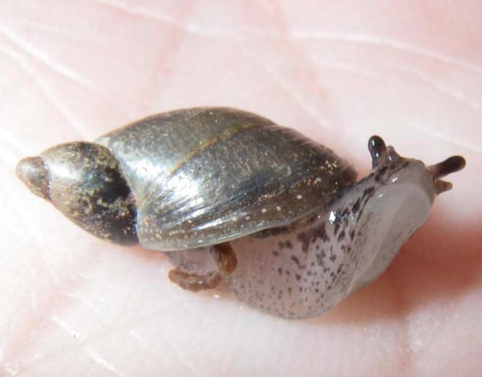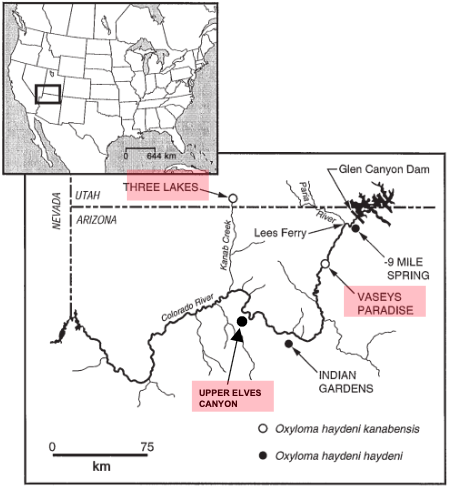The Kanab Ambersnail is a critically endangered snail that is endemic to three locations in the Grand Canyon region. Complicating restoration efforts is the lack of information about the snail and its habitat, origin, and population size. A recent presentation by Ann Holmes, a UC Davis Graduate ecology student described the Kanab Ambersnail and its habitat, the conflicts between snail conservation and ecosystem conservation, the lack of genetic data, and she provided recommendations for where we go from here.
What is the Kanab Ambersnail?
The Kanab Ambersnail (Oxyloma haydeni kanabensis), shown in Figure 1, was first discovered in 1909 in Utah. Initially, it was thought to be another known species of snail, until 1949 when it was reclassified to what we know today. The snail is about 1 cm in length, which is about the diameter of a dime. Typical lifespan of the snail is 15 months, with periods of dormancy during the cooler winter months. Due to the small size and dormancy periods it has been difficult to survey the population size of the snail.
Where does the Kanab Ambersnail live?
Habitat for the snail consists of ground water springs and wetlands. Typically, within these locations the snail is found near or on Crimson Monkeyflower. However, it is not known if the snail’s survival is dependent on the Monkeyflower. Any destruction or modification to this habitat will likely affect the snail. Even know the snail lives in wetlands, it breathes air, and can only survive in water for 2-3 days.
Shown in Figure 2 are the three sites where the snail is known to live; Vasey’s Paradise, Upper Elves Canyon and Three lakes. Birds are thought to be the primary dispersers of the snail, either by transporting eggs that become stuck on the bird, or by ingesting adult snails and passing them through the digestive system. Snails residing in the Upper Elves Canyon were from a population of 340 snails that were transported by humans from 1998 to 2002 as a conservation measure.

Concern with High Flow Experiments?
High flow experiments which have been used to restore fish habitat, riparian areas and beaches along the river can have negative consequences for invertebrates, such as the Kanab snail. The concern is the high flows may completely wash away the snails or scour the habitat so much that it can no longer sustain them. In one such high flow experiment in 1996 the concern was so great that a plan was made to relocate 90% of the snails below the worst- case inundation height at the Vasey’s Paradise location. Following the experiment, snails would be returned if the habitat was still suitable. This plan ran into a series of complications because there were more snails than estimated and many of the snails were dormant, which would have required more destruction of their habitat. A new plan was developed where 75% of snails in 50% of the inundation area were collected. Ultimately, the high flow destroyed roughly 16% of the habitat at the Vasey’s site.
Is conservation of the Kanab Ambersnail at odds with conservation of the Grand Canyon Ecosystem?
The high flow experiments are thought of as beneficial for the Grand Canyon Ecosystem because it restores the river flows to the pre- Glen Canyon dam conditions. This is in direct conflict with the Kanab snail because the flows destroy its habitat. Thus, a major concern for policy makers is deciding how to balance the needs of the Kanab Ambersnail against the needs of the entire system. The Endangered Species Act shapes this discussion because it requires that both the species and habitats be protected. Specifically, each unit (or distinct population) must be protected.

How can genetic data help make informed policy decisions?
By examining the genes of the current snail population, the amount of diversity within and between each subpopulation can be determined. More genetic diversity is better, because it can help the snail re-evolve if their habitat substantially changes. Several studies have also been performed to determine how
Kanab Ambersnail populations are related to each other and other snail species. One of the genetic studies showed the Three Lakes and Vasey’s Paradise populations were not each others’ closest relatives, possibly challenging the notion that the Kanab Ambersnail is a distinct species. However, comparison with other genetic studies render this finding inconclusive, and more data collected with more sophisticated techniques is required. Currently, the lack of good genetic knowledge complicates conservation efforts.
Where do we go from here?
Prior to any major policy decisions affecting the Kanab Ambersnail, such as removal from the Endangered Species list, more data is needed. More studies will help determine if the Kanab snail is genetically diverse, and if it is a distinct species. To remove the Kanab snail from the endangered species list will require 10 separate population sites with long-term viability, formal land management designations and plans for the different populations. Since these conditions are not currently met, protections cannot be removed.
